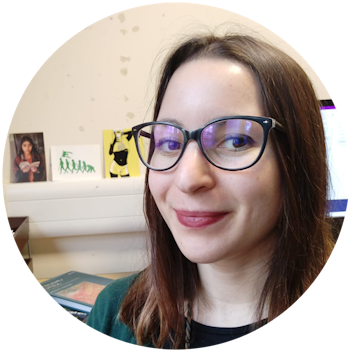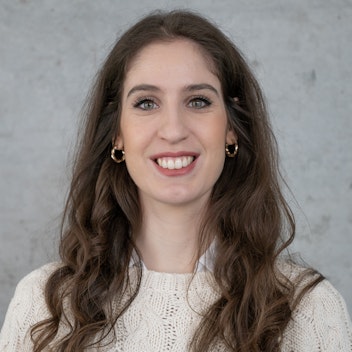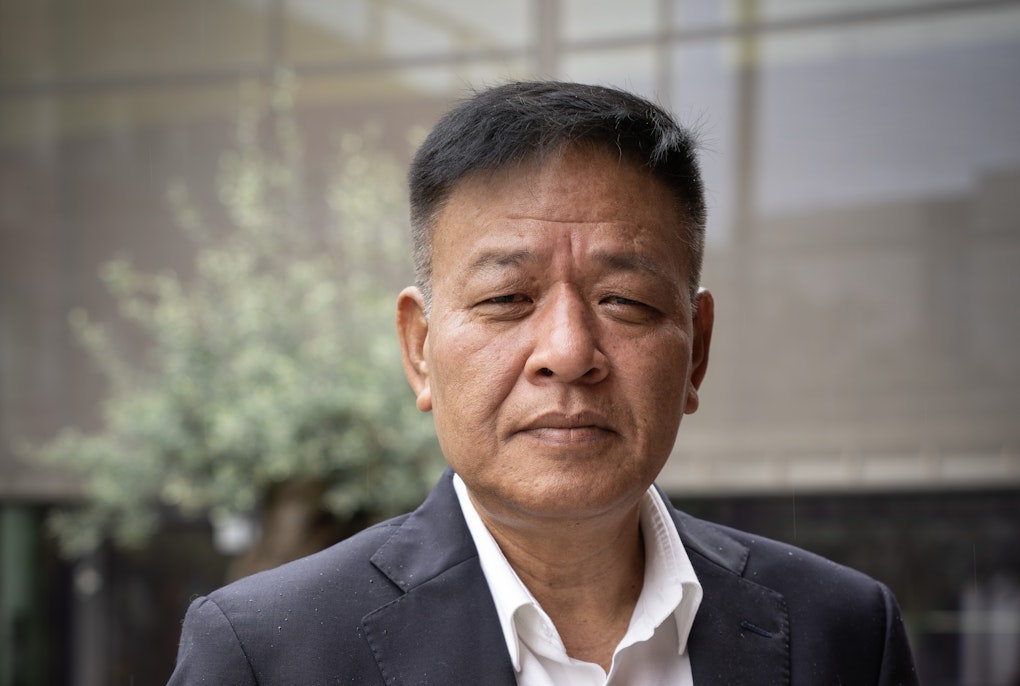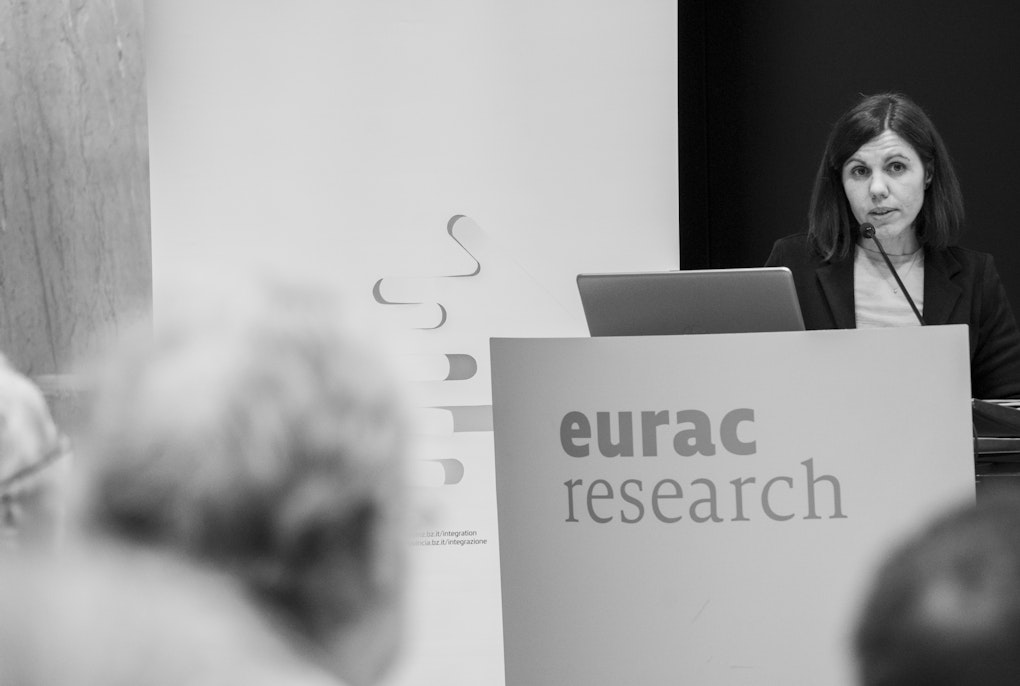magazine_ Interview
"20 years ago, people thought migration wasn’t an issue in South Tyrol"
Conversations between disciplines: interview with linguist Andrea Abel and lawyer Günther Rautz.
Minorities and multilingualism: The research areas of Günther Rautz and Andrea Abel are as socio-politically central as they are sensitive in South Tyrol as well as being a clear mirror of how the society is changing. Rautz, a lawyer, and his team began researching new minorities at an early stage, while Abel, a linguist, advocates understanding multilingualism in a comprehensive sense that includes all languages and varieties. Both are convinced that diversity is highly valuable asset.
Ms. Abel, which foreign language would you advise anyone to learn that will be useful in South Tyrol in the future?
Andrea Abel: Chinese or Arabic would be a good idea. Not only can they open large cultural areas, but they are also able to give you knowledge about how other languages work. They have fundamental differences to our European languages, which is incredibly exciting. Chinese, for example, has no grammar as we generally consider it. Nouns have no gender, and they are not declined. And Chinese is a tonal language. That means that words take on different meanings depending on the pitch contour of the voice.
"One can assume that the languages present in South Tyrol are well over 100."
Andrea Abel
You've been researching multilingualism for almost 25 years. How has the linguistic landscape in South Tyrol changed over this period?
Abel: Enormously. According to data from the regional statistical office (Astat), the foreign resident population at the end of the 1990s was 10,000 people; in 2020 it was close to 50,000. The most important countries of origin are Albania, Germany, Pakistan, Morocco, Romania, Kosovo. In total, people from 140 countries live in South Tyrol. One cannot directly conclude this from the languages spoken, as the example of Pakistan shows, where more than 50 languages are used. But one can assume that the languages present in South Tyrol number well over 100. From our studies we know that in an average urban middle school children speak about eight different languages.
Has the more colorful language landscape also changed language didactics over the years?
Abel: Definitely. And it’s ongoing. There are many different approaches to multilingual didactics. One buzzword is language-sensitive teaching. Today, more consideration must be given to the fact that students in some classes have neither German nor Italian or Ladin as their first languages.
Mr. Rautz, you have also been dealing with the topic of minorities, migration, and integration for the past 25 years. For a long time now, people in South Tyrol have been talking about old minorities - German and Ladin speakers - and new ones. Does this make the old minorities a little less of a minority? Or phrased in a different way: has the presence of new minorities lead to a rapprochement between German-, Ladin- and Italian-speaking South Tyroleans?
Günther Rautz: South Tyrol is a unique case in Europe with its three recognized language groups. Due to the declaration of language group affiliation, we are constantly confronted with the majority and minority situation, which ranges from political representation to the media and to the school systems. Depending on where I live and in which environment I move, I can sometimes feel like I belong to the majority, sometimes to the minority, and this can change several times in one day depending on the situation. People with a migration background make up more than ten percent of the population, which is more than the share of the Ladin language group; however, they do not represent a closed fourth group. They have to choose, as far as their status allows, one of the three language groups. From this point of view, immigration has not really changed the system and the relationship between the three language groups; at most, it has added another nuance.
Abel: We recently interviewed parents with a migration background in a pilot study. Some of them told us how stressful it was for them to decide whether to send their children to German or Italian school. And the decision is far-reaching because socialization initially takes place in a relatively monolingual world. Schools, too, are in a quandary: on the one hand, many languages in a class are a challenge, on the other, they want to strengthen their own language group, and for that it is an advantage to recruit new "language group members".
Is there also a political calculation behind the fact that the number of children who do not have one of the three official languages as their mother tongue is increasing in German-language schools?
Abel: Since schools have a major impact on children’s language socialization, your question is justified. Nevertheless, I believe the mission of the school in South Tyrol is to offer children of different origins as equal educational opportunities as possible. The school does not act out of political calculation. Right now, schools are more concerned about the challenges of plurilingual classrooms.
Rautz: What is certainly not being pursued in South Tyrol is an aggressive language assimilation policy such as the one in Catalonia, for example. A Catalanization policy is being pursued there to position Catalonia more strongly vis-à-vis Spain. This even goes as far as translating Hollywood blockbusters into Catalan.
Wouldn't a bilingual or multilingual school be advantageous so that children and young people in South Tyrol grow up in less separate worlds in the future?
Abel: Of course, it could be an advantage. However, one would also have to discuss to what extent such a model, which in the public discourse concerns the German and Italian languages particularly, and to some extent English, remains current against the background of increasing linguistic heterogeneity. And if one considers a so-called bilingual school, one must also consider whether the organization of schools in politically and administratively separate systems is suitable for this. One would have to think in completely new ways.
Rautz: OSCE delegations and minority and state representatives from crisis areas have always shown great interest in the Ladin school model during their visits to South Tyrol. This is a parity school in which, to put it simply, 50 percent of the subjects are taught in German and 50 percent in Italian. Ladin is an auxiliary language. The impression is that Ladin is not neglected and that the students have a better command of German and Italian as second languages than in the rest of South Tyrol. Since there is only the parity school, children with a migratory background in Ladin communities learn three additional languages at once, and it works.
Abel: The Ladin model is certainly unique. It is clearly designed to promote multilingualism among children. What I find interesting is that when the Ladin school sometimes does worse than the Italian or German school in standardized learning level surveys conducted by the Istituto Nazionale per la Valutazione del Sistema Educativo di Istruzione e di Formazione (INVALSI), however it is argued that the standard used is not appropriate: The tests are based on a monolingual norm, while the multilingualism of Ladin children and adolescents is not taken into account. This argument has its justification.
Mr. Rautz, you are originally from Carinthia, which also has a language minority, the Slovenes. As a researcher, do you ever make comparisons? And does your view from the outside help you to analyze the situation in South Tyrol?
Rautz: I have lived in South Tyrol longer than in Carinthia and feel at home here. I make comparisons, of course: For example, in the 1950s and 1960s, the situation of the Ladins in South Tyrol can still be compared to that of the Carinthian Slovenes; the pressure to assimilate was very high. With the implementation of the Second Autonomy Statute - which, by the way, celebrates its 50th year in 2022 - South Tyrol gained its own competences, which provided for a huge economic and socio-political awakening, first for the German language group, but also for the Ladin one. As a result, being a member of a minority, one became more self-confident in South Tyrol. In Carinthia, with the "Ortstafelsturm" - the violent dismantling of bilingual place-name signs, which started in 1972, things went in the opposite direction as far as the value of a language and one's own culture was concerned. There was massive assimilation pressure from the German Carinthian side. In the 1970s and 1980s it was suddenly no longer opportune to speak Slovene in public. I was born into this period and, although I grew up in the bilingual area, I never learned Slovenian. The situation changed only in 2004, when Slovenia joined the EU. Today Slovenian is spoken more and taught in schools. However, one or two generations who have not passed on the Slovene language or culture have been lost.
The topics you deal with, multilingualism and migration, are always a source of controversy in the media. To what extent does this influence your research work?
Abel: If I recognize multilingualism as a value, which South Tyrol fundamentally does, then I can conduct evidence-based research on it. And that is exactly what we are doing. We investigate how multilingualism functions, how language acquisition takes place in a multilingual context and which multilingual didactic approaches are successful. But of course, even if the premise is clear, one or the other project partner may drop out because the results of the studies do not seem politically opportune - as happened, for example, with a study on the second language competencies of South Tyrolean high school students about five years ago, which in some cases produced results that were not expected. In any case, we were able to show that we had worked with clean and transparent data.
Rautz: You have to give scientifically precise answers to socio-politically sensitive questions. Data must be double- and triple-checked. There is a big difference between contract research and research on one's own initiative. In contract research especially, the client may have certain expectations. This makes it all the more important to maintain scientific standards. That means making the client aware in good time that the results may not be what they expect. And of course, as a scientist, I also have to be able to live with being criticized or having a result exploited politically. But when I look back at the 25 years I have been doing research in South Tyrol, Eurac Research has always shown a strong backbone. Consistent work that bears fruit on a local and international level. And if I can take something positive from the pandemic, it is the increase in scientific discourse. Never before has there been so much discussion about science or with scientists as during the pandemic.
Abel: Yes, science has never been so present. But not only in a positive sense. In my perception, society has also been very unsettled. People often had the feeling that the science was too complex, that there were never any clear statements, that no one had a clear view.
Rautz: I don't see it quite so negatively. During the crisis, scientists had to learn to deal with a lot of pressure and to think outside the scientific box - and by that I also mean outside the box of individual disciplines. In this sense, the pandemic was a warm-up for the transdisciplinary management of future crises. The hope is that science, politics, and society will approach each other more.
Mr. Rautz, you mentioned research under one’s own initiative. What research questions are driving you?
Rautz: 20 years ago, people thought that migration was not an issue in South Tyrol. At that time, Eurac Research had already begun to study the topic of new minorities. The provincial government was rather puzzled as to what the point of such research topics was, since they believed that one should concentrate on the long-established minorities. Years later, when the state government approached us with contract research in this area, we didn't have to work our way in. Research must always be one step ahead and not lag behind sociopolitical issues.
Abel: The situation is similar with research on multilingualism. At Eurac Research, we have always understood this as comprehensive multilingualism, which includes all languages and not just the classic foreign languages - in the sense of elite multilingualism. However, we also research local dialects, for example in social media. Dialects and other linguistic varieties - this may come as a surprise to some people outside the field - also enrich our own language repertoires. We also call this multilingualism within a language, inner multilingualism, as opposed to outer multilingualism.
Ms. Abel, what would your ideal South Tyrolean school look like in 30 years?
Abel: A school that offers all children as many equal opportunities as possible for their careers. And this includes supporting them in their multilingual needs, from dialect to all the languages commonly used in South Tyrol. My impression is that we are already on a good path, and research in this area is also being taken more and more seriously.
"In the area of minority protection, South Tyrol still lacks a law to protect the Roma."
Günther Rautz
Mr. Rautz, how does South Tyrol compare to other Italian regions in terms of integration? And where is it headed?
Rautz: South Tyrol is basically in a good position. In the area of minority protection, a law to protect the Roma is still missing. This already exists in some other Italian regions. As far as the future is concerned, it's important to engage the young generation who should be actively involved in the discussion about the further development of autonomy and the coexistence of an increasingly diverse society. With this cultural diversity and an increasingly attractive living and working environment, we can also position ourselves in the competition for the best minds throughout Europe.
Andrea Abel
Andrea Abel and Günther Rautz are two of Eurac Research’s original members. Abel, a full-blooded linguist, has been working at the Institute for Applied Linguistic Research since 1997 and has been its head since 2016. "Professionally deformed," she turns (almost) everything in life into a project and wants to get to the bottom of things. To give her busy brain a break, she lives out her creativity through sewing projects and also likes to run her heart out.
Günther Rautz
Günther Rautz studied law and philosophy in Graz, Bari, Rome and Innsbruck. He has also been with Eurac Research since 1997 and has been head of the Institute for Minority Rights since 2018. As a minority rights advisor, he travels a lot, but avoids pointless flying and has long been crossing Europe on night trains even before Fridays for Future came on the scene.









